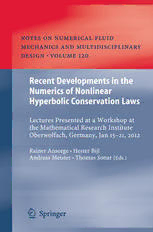Table Of ContentNotes on Numerical Fluid Mechanics
and Multidisciplinary Design 120
SeriesEditors
Prof.Dr.WolfgangSchröder
(GeneralEditor),RWTHAachen,LehrstuhlfürStrömungslehreundAerodynamisches
Institut,Wüllnerstr.5a,52062Aachen,Germany
E-mail:offi[email protected]
Prof.Dr.Ir.BendiksJanBoersma
ChairofEnergytechnology,DelftUniversityofTechnology,Leeghwaterstraat44,
2628CADelft,TheNetherlands
E-mail:[email protected]
Prof.Dr.KozoFujii
SpaceTransportationResearchDivision,TheInstituteofSpaceandAstronautical Science,
3-1-1,Yoshinodai,Sagamihara,Kanagawa,229-8510,Japan
E-mail:fujii@flab.eng.isas.jaxa.jp
Dr.WernerHaase
HöhenkirchenerStr.19d,D-85662Hohenbrunn,Germany
E-mail:[email protected]
Prof.Dr.MichaelA.Leschziner
AeronauticsDepartment,ImperialCollegeofScienceTechnologyandMedicine,
PrinceConsortRoad,LondonSW72BY,UK
E-mail:[email protected]
Prof.Dr.JacquesPeriaux
38,BoulevarddeReuilly,F-75012Paris,France
E-mail:[email protected]
Prof.Dr.SergioPirozzoli
DipartimentodiMeccanicaeAeronautica,UniversitàdiRoma“LaSapienza”,
ViaEudossiana18,00184,Roma,Italy
E-mail:[email protected]
Prof.Dr.ArthurRizzi
DepartmentofAeronautics,KTHRoyalInstituteofTechnology,Teknikringen8,
S-10044Stockholm,Sweden
E-mail:[email protected]
Dr.BernardRoux
L3M-IMTLaJetée,TechnopoledeChateau-Gombert,F-13451MarseilleCedex20,France
E-mail:[email protected]
Prof.Dr.YuriiI.Shokin
InstituteofComputationalTechnologies,SiberianBranchoftheRussianAcademy
ofSciences,Ac.LavrentyevaAve.6,630090Novosibirsk,Russia
E-mail:[email protected]
Forfurthervolumes:
http://www.springer.com/series/4629
Recent Developments in the
Numerics of Nonlinear
Hyperbolic Conservation Laws
Lectures Presented at a Workshop at the
Mathematical Research Institute Oberwolfach,
Germany, Jan 15–21, 2012
Rainer Ansorge, Hester Bijl, Andreas Meister,
and Thomas Sonar (Eds.)
ABC
Editors
Prof.RainerAnsorge Prof.AndreasMeister
DepartmentofMathematics DepartmentofMathematicsand
UniversityofHamburg NaturalSciences
Hamburg UniversityofKassel
Germany Kassel
Germany
Prof.HesterBijl
DepartmentofAerospaceEngineering Prof.ThomasSonar
DelftUniversityofTechnology InstituteforComputationalMathematics
Delft TechnicalUniversityofBraunschweig
TheNetherlands Braunschweig
Germany
ISSN1612-2909 e-ISSN1860-0824
ISBN978-3-642-33220-3 e-ISBN978-3-642-33221-0
DOI10.1007/978-3-642-33221-0
SpringerHeidelbergNewYorkDordrechtLondon
LibraryofCongressControlNumber:2012947385
(cid:2)c Springer-VerlagBerlinHeidelberg2013
Thisworkissubjecttocopyright.AllrightsarereservedbythePublisher,whetherthewholeorpartof
thematerialisconcerned,specificallytherightsoftranslation,reprinting,reuseofillustrations,recitation,
broadcasting,reproductiononmicrofilmsorinanyotherphysicalway,andtransmissionorinformation
storageandretrieval,electronicadaptation,computersoftware,orbysimilarordissimilarmethodology
nowknownorhereafterdeveloped.Exemptedfromthislegalreservationarebriefexcerptsinconnection
with reviews or scholarly analysis or material supplied specifically for the purpose of being entered
and executed on a computer system, for exclusive use by the purchaser of the work. Duplication of
this publication or parts thereof is permitted only under the provisions of the Copyright Law of the
Publisher’slocation,initscurrentversion,andpermissionforusemustalwaysbeobtainedfromSpringer.
PermissionsforusemaybeobtainedthroughRightsLinkattheCopyrightClearanceCenter.Violations
areliabletoprosecutionundertherespectiveCopyrightLaw.
Theuseofgeneraldescriptivenames,registerednames,trademarks,servicemarks,etc.inthispublication
doesnotimply,evenintheabsenceofaspecificstatement,thatsuchnamesareexemptfromtherelevant
protectivelawsandregulationsandthereforefreeforgeneraluse.
Whiletheadviceandinformationinthisbookarebelievedtobetrueandaccurateatthedateofpub-
lication,neithertheauthorsnortheeditorsnorthepublishercanacceptanylegalresponsibilityforany
errorsoromissionsthatmaybemade.Thepublishermakesnowarranty,expressorimplied,withrespect
tothematerialcontainedherein.
Printedonacid-freepaper
SpringerispartofSpringerScience+BusinessMedia(www.springer.com)
Preface
AworkshoponMethodsofveryhighorderfornonlinearhyperbolicconservation
laws andtheiruse in science andengineeringtookplaceatthe MathematicalRe-
searchInstituteOberwolfachfromJan15toJan21,2012.
The development of Spectral Element methods in recent years as well as
Discontinuous Galerkin and Essentially Non-Oscillatory or Weighted Essentially
Non-Oscillatory Finite Volume methodshave opened new fields for very high or-
dernumericalmethods,i.e.methodsofordersstartingatfourorfive,andtheiruse
in science and engineering.In case of such methods, convergenceresults can not
yetbeatissue.Instead,methodsofveryhighorderingeneraldemandresultsfrom
areaslikeapproximationtheoryandfilterdesign.InDiscontinuousGalerkinmeth-
odsandinSpectralElementmethodsonsimplicialmeshes,forexample,orthogonal
polynomialsonsimplicesseemtobetheappropriatechoice.
Besidesapproximationtheorythereisalsoagrowingneedconcerninghighorder
quadraturerulesonsimplices.Althoughthisareaseemstobequiteolditshouldbe
lookedatagainwithaparticularviewonrobustandefficienthighordermethods.
Moreover,afurtheringredientnecessaryforthestablenumericalapproximation
ofconservationlawswithveryhighordermethodsliesinfilterdesign.Oneofthe
centralquestionstobeansweredconcernstheinformationonoscillationswhichcan
bederivedfromthecoefficientsoforthogonalpolynomialsonsimplices.
The aim of the workshop was to bring together experts from the fields of nu-
mericalmethodsfor conservationlaws, approximationtheory,filter design, image
recovery,andengineeringapplications.
We,theorganisers,arereallysatisfiedthatmanyofthecontributionstothiswork-
shop can be publishedin this volume of the NNFM series of SpringerVerlag and
we thank the publishersas well as the General Editor of this series, W. Schro¨der,
Aachen,fortheirhelpandsupport.
VI Preface
We alsothanktheOberwolfachInstituteanditsDirector,G.-M.Greuel,forthe
interestinourworkshop.
Hamburg,Delft,Kassel,Brunswick RainerAnsorge
April2012 HesterBijl
AndreasMeister
ThomasSonar
Contents
A SecondOrder Accurate Kinetic RelaxationScheme forInviscid
CompressibleFlows ............................................. 1
K.R.Arun,M.Luka´cˇova´-Medvid’ova´,PhoolanPrasad,S.V.RaghuramaRao
1 Introduction.............................................. 2
2 RelaxationSystemforEulerEquations ....................... 3
3 KineticRelaxationScheme ................................. 6
3.1 ConservationPropertyoftheScheme................. 8
3.2 PositivityPreservingProperty ....................... 9
3.3 EntropyStabilityoftheScheme ..................... 11
4 SecondOrderAccurateKineticRelaxationScheme............. 12
4.1 SecondOrderAccuracyinTime ..................... 13
4.2 SecondOrderAccuracyinSpace .................... 16
5 NumericalCaseStudies.................................... 18
6 ConcludingRemarks ...................................... 22
References..................................................... 23
OnOne-DimensionalLowMachNumberApplications................ 25
MariaBauer,ElisabettaFelaco,IngenuinGasser
1 Introduction.............................................. 25
1.1 GeneralSetting ................................... 26
1.2 InitialandBoundaryConditions ..................... 27
1.3 AsymptoticRegimes............................... 28
2 TheGasDynamicsinaChimney ............................ 28
2.1 Asymptotics...................................... 29
2.2 NumericalSimulations............................. 31
3 ModellinganEnergyTower ................................ 33
3.1 AsymptoticsandNumericalSimulations .............. 35
4 Conclusion............................................... 38
References..................................................... 38
VIII Contents
HighOrderandUnderresolution .................................. 41
AndreaBeck,GregorGassner,Claus-DieterMunz
1 Introduction.............................................. 41
2 NumericalModel ......................................... 42
2.1 PhysicalModel ................................... 42
2.2 DiscontinuousGalerkin ............................ 43
2.3 StabilityandDe-aliasing ........................... 45
3 HighOrderSimulationofUnderresolvedTurbulence ........... 50
3.1 Highvs.LowOrderSimulationsatModerate
Resolutions ...................................... 50
3.2 Underresolution:StabilitybyOverintegration.......... 51
3.3 AccuracyandEfficiency............................ 52
4 Conclusion............................................... 54
References..................................................... 55
SolvingNonlinearSystemsInsideImplicitTimeIntegrationSchemesfor
UnsteadyViscousFlows .......................................... 57
PhilippBirken
1 Introduction.............................................. 57
2 Navier-StokesEquations ................................... 59
3 ImplicitTimeDiscretization ................................ 59
4 SolvingNonlinearEquationSystems......................... 60
4.1 MultigridSchemes ................................ 60
4.2 NewtonSchemes.................................. 65
5 SummaryandConclusions ................................. 69
References..................................................... 69
DiscreteFlux-CorrectedTransport:
NumericalAnalysis,Tensor-ValuedExtensionandApplication
inImageProcessing ............................................. 73
MichaelBreuß,BernhardBurgeth,LuisPizarro
1 Introduction.............................................. 73
2 ThePDEsofMathematicalMorphology...................... 74
3 ReviewoftheDFCTMethod ............................... 75
4 AnalysisoftheDFCTScheme .............................. 76
5 MathematicsofMatrixFields ............................... 78
6 PDE-BasedMorphologyforMatrixFields .................... 81
7 NumericalExperiments .................................... 83
8 Conclusion............................................... 86
References..................................................... 86
QuantificationofNumericalandPhysicalMixinginCoastalOcean
ModelApplications.............................................. 89
HansBurchard,UlfGra¨we
1 Introduction.............................................. 89
2 ModelEquations.......................................... 90
Contents IX
2.1 ContinuousEquations.............................. 90
2.2 DiscretisationandNumericalMixingAnalysis ......... 92
3 Applications ............................................. 96
3.1 GeneralEstuarineTransportModel(GETM)........... 96
3.2 FreshwaterLens .................................. 96
3.3 WesternBalticSea ................................ 99
4 Conclusions..............................................101
References.....................................................102
DealingwithParasiticBehaviourinG-SymplecticIntegrators.......... 105
J.C.Butcher
1 Introduction..............................................105
2 DissipativeandConservativeProblems .......................106
3 Runge–KuttaMethods .....................................108
3.1 AlgebraicallyStable andSymplecticRunge–Kutta
Methods .........................................108
3.2 Runge–KuttaSimulations...........................109
4 GeneralLinearMethods....................................111
4.1 AlgebraicallyStableandG-SymplecticGeneralLinear
Methods .........................................113
4.2 OrderandStartingMethods.........................114
5 CorruptionofLong-TermSolutionbyParasitism...............115
5.1 CancellationUsingCompositions....................116
5.2 CancellationUsingScaledSteps.....................116
5.3 NumericalExperiments ............................117
5.4 Parasitism-FreeMethods ...........................119
6 DerivationofaNewMethod................................120
6.1 StartingMethod...................................122
References.....................................................123
AnAdaptiveArtificialViscosityMethodfortheSaint-VenantSystem.... 125
YunlongChen,AlexanderKurganov,MinlanLei,YuLiu
1 Introduction..............................................125
2 AdaptiveArtificialViscosityMethod.........................127
2.1 SourceTermQuadrature............................130
2.2 CorrectionoftheReconstructedPointValues ..........130
2.3 Desingularization .................................131
2.4 PositivityPreservingProperty .......................132
3 NumericalExamples ......................................133
References.....................................................140
DiscontinuousGalerkinMethod–ARobustSolverforCompressible
Flow .......................................................... 143
MiloslavFeistauer,JanCˇesenek,Va´clavKucˇera
1 Introduction..............................................143
2 DescriptionofCompressibleFlow ...........................144
X Contents
3 DiscreteFlowProblem.....................................147
3.1 SpaceDiscretizationbytheDiscontinuousGalerkin
Method..........................................147
3.2 TimeDiscretizationbytheBDFMethod ..............150
3.3 Space-TimeDiscontinuousGalerkinMethod...........151
4 NumericalExperiments ....................................152
4.1 InviscidStationaryFlowwithLowMachNumber ......152
4.2 FlowInducedAirfoilVibrations .....................154
5 Conclusion ..............................................158
References.....................................................159
A RigorousApplicationoftheMethodofVerticalLines toCoupled
SystemsinFiniteElementAnalysis................................. 161
StefanHartmann,SteffenRothe
1 Introduction..............................................161
2 UncoupledSituationandBasicInitialBoundary-ValueProblem ..164
3 CoupledProblems.........................................167
4 Examples................................................168
4.1 Electro-ThermalCoupling ..........................168
4.2 Thermo-Viscoplasticity.............................170
5 Conclusions..............................................172
References.....................................................173
Monotonicity Conditions for Multirate and Partitioned Explicit
Runge-KuttaSchemes ........................................... 177
WillemHundsdorfer,AnnaMozartova,ValeriuSavcenco
1 Introduction..............................................177
2 SomeMultirateSchemesofOrderOneandTwo ...............178
2.1 ExamplesofSimpleSchemesfortheAdvection
Equation.........................................178
2.2 SomeSchemeswithOneRefinementLevelforGeneral
Semi-discreteProblems ............................179
3 PartitionedRunge-KuttaMethods............................184
3.1 GeneralProperties.................................184
4 MonotonicityandConvexEulerCombinations.................188
4.1 Maximum-NormMonotonicity......................189
4.2 MonotonicityunderAssumption(27).................190
4.3 MonotonicityunderAssumption(26).................191
4.4 Application:MultirateSchemeswithOneLevelof
Refinement.......................................192
5 ConcludingRemarks ......................................193
References.....................................................194
Contents XI
OntheConstructionofKernel-BasedAdaptiveParticleMethodsin
NumericalFlowSimulation ....................................... 197
ArminIske
1 Introduction..............................................197
2 HyperbolicConservationLaws..............................198
3 FiniteVolumeParticleMethod(FVPM) ......................199
4 WENOReconstruction.....................................200
5 Kernel-BasedReconstructioninParticleFlowSimulations.......201
6 ReconstructionbyPolyharmonicSplines......................204
7 NumericalAspectsofPolyharmonicSplineReconstruction ......205
7.1 SpectralConditionNumberofReconstructionMatrix ...205
7.2 ConditioningofReconstructionProblem ..............207
7.3 Scale-InvarianceoftheLebesgueConstant ............208
7.4 StableEvaluationoftheReconstruction...............210
7.5 LocalApproximationOrder.........................211
7.6 AdvantagesofPolyharmonicSplineReconstruction.....212
8 AdaptionRules ...........................................213
8.1 ErrorIndication...................................214
8.2 CoarseningandRefinement .........................215
9 OilReservoirSimulation:TheFive-SpotProblem ..............216
9.1 TheFive-SpotProblem.............................216
9.2 AdaptiveParticleFlowSimulation ...................219
References.....................................................220
An Assessment of the Efficiency of Nodal Discontinuous Galerkin
SpectralElementMethods........................................ 223
DavidA.Kopriva,EdwinJimenez
1 Introduction..............................................223
2 TheDGSEM .............................................224
3 RelativeEfficiencyoftheDGSEMApproximation .............226
4 Implicitvs.ExplicitComputation............................229
4.1 TheEffectofParallelism ...........................233
5 Conclusions..............................................234
References.....................................................235
Sub-cyclingStrategiesforMaritimeTwo-PhaseFlowSimulations....... 237
ManuelManzke,Jan-PatrickVoss,ThomasRung
1 Introduction..............................................237
2 ComputationalMethod.....................................238
2.1 GoverningEquationsandComputationalAlgorithm ....238
2.2 Free-SurfaceModel................................239
2.3 DiscreteMixture-FractionEquation ..................240
3 Sub-cyclingStrategy ......................................241
4 Results ..................................................243
4.1 Two-DimensionalDamBreak .......................243
4.2 DragPredictionofaTanker .........................245

